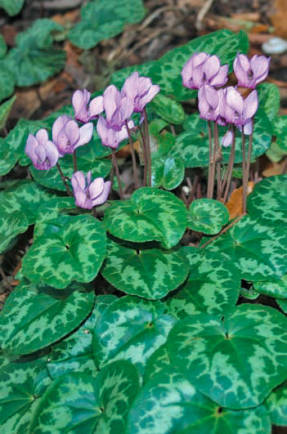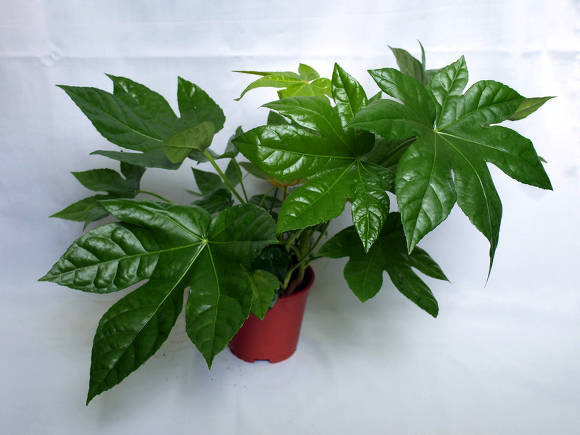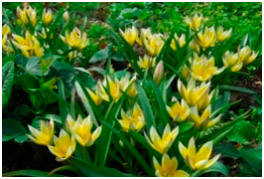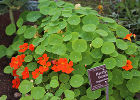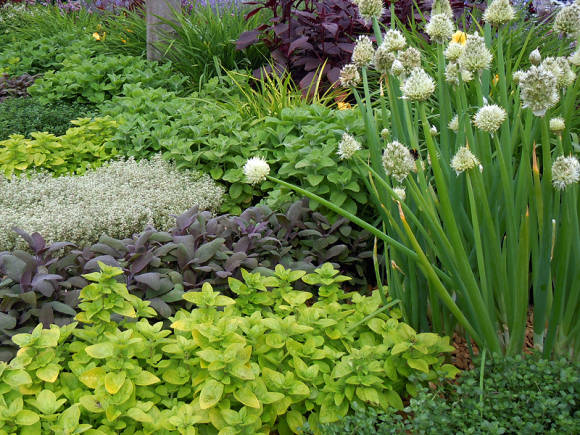It is not for nothing that the rose bears the name of the Queen of Flowers, since ancient times it has been considered a symbol of love and beauty. She was, is and, probably, will be the most desirable flower for women. To prolong the joy of the gift, to preserve the memory longer, roses in pots are increasingly presented. For these purposes, many varieties have been bred that differ in miniature growth.
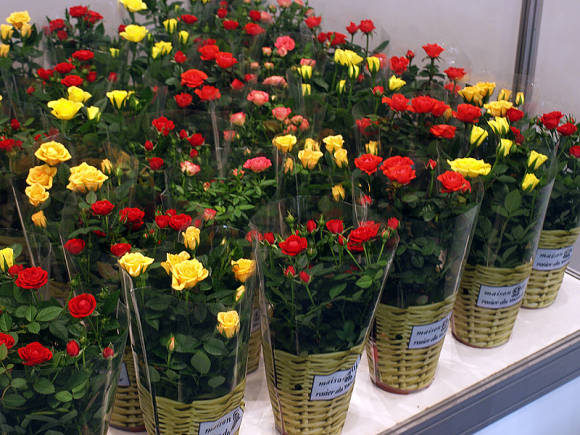 |
Among amateurs common rose bengalalso called Chinese or indian... This name refers to varieties rose chinese(Rosachinensis). Flowers of all kinds of colors, except for yellow, semi-double or double structure, single or 2-3 in loose inflorescences, usually without aroma. They are characterized by abundant continuous flowering and unpretentiousness, thanks to these qualities, Bengal roses have become so popular as house plants. In culture for a very long time, from the end of the 18th century.
The garden group of miniature roses, which is most commonly used in indoor culture, also originated from the Chinese rose. They differ from Bengal roses in smaller flowers and leaves and compact growth.
Our flower shops supply hybrid potted roses, mainly grown in Holland and Denmark:
roses of Cordana - a line of varieties of miniature roses, which are characterized by the small size of the plant and flower itself, a long flowering period, a variety of shades of color of the petals;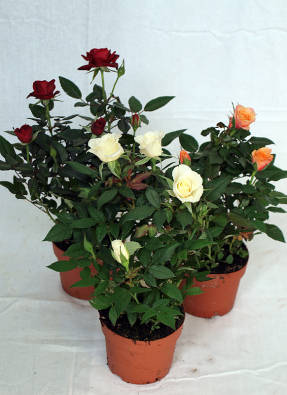
- roses Turbo, the size of the bush resembles the Cordana rose, but with larger flowers. These varieties are also characterized by long flowering and a variety of colors.
- Roses Patio, which differ in the larger size of both the plant itself and the flower, prolonged flowering and a variety of colors. They belong to the floribunda garden group, are distinguished by their short stature (no more than 50 cm).
Roses are grown commercially on special plantations. For uniform growth and flowering, daylight hours are required, close to 12 hours with high light intensity. Historically, plantations were located in subequatorial countries (Ecuador, Colombia, Ethiopia, Kenya), because it was there that it was possible to provide this plant with full lighting throughout the year. Currently, the lack of natural light in winter can be compensated for by artificial lighting, so now roses are successfully grown in more northern countries, in Holland and Russia.
Modern plantations for growing roses are well-equipped, spacious indoor greenhouse complexes, where, using computer climate control, they are created optimal conditions... The greenhouses are equipped with a modern irrigation system that irrigates the soil, not the plants. The hotter, the more often watering, sometimes several times a day in small doses - this ensures constant and moderate soil moisture. With each watering, the rose receives fertilization in small doses. Good ventilation and keeping the leaves dry will protect the plants from fungal infections. By opening and closing the transparent roof, the optimum temperature is ensured, + 23 ° C during the day and + 16 ° C at night. If pests are found, the roof is tightly closed and the plants are treated with insecticides.
When conditions such as in greenhouses are created, the rose will not only grow well, but also bloom continuously.
Content of a rose in summer usually not a big hassle.
You just need to find very bright place, preferably on an open south-facing balcony. It will be possible to transfer the plant there when the danger of night frosts has passed and keep until the onset of cold weather. Outdoors, the rose tolerates direct sun well.However, immediately after the purchase, a gradual adaptation of the plant to the sun is required, because for a long journey it was deprived of bright light and can get burns. If the rose is on a windowsill, then a little protection from midday rays will be required. In order not to damage the roots, it is imperative to protect the pot from overheating in the sun, put it in a light planter or wrap it in white paper. And provide the plant with good ventilation, place it near an opening window. When growing a rose in partial shade or in the shade, it will wither and refuse to bloom.
 |
Watering carry out regularly and in moderation, the soil should always remain slightly damp between waterings, only a slight drying of the top layer is permissible. Do not bring the soil to excessive moisture, this can rot the roots. Watering must be done from above with warm, settled water. Stagnation of water in the sump is unacceptable.
On hot days, it is necessary to often spray the rose (but not in the sun), this will help the plant to withstand high temperatures.
Top dressing are applied during the entire period of plant growth (in spring-summer or throughout the year with additional illumination in autumn-winter), preferably often and in small doses (a weekly dose can be divided into 7 parts and applied one part every day), this provides more uniform assimilation and prevents strong soil salinization. The rose has specific requirements for the composition of the dressings, therefore, only special fertilizers should be used, which should also include trace elements. Partially, you can apply fertilizers by foliar method, by spraying on the leaves with a weak fertilizer solution. Depending on the wintering method (warm or cold), in August, a change in the doses and composition of the dressings may be required. During a warm winter, when the rose does not plunge into deep sleep, they continue to feed with standard fertilizer for roses. During cold wintering, with immersion in deep sleep, nitrogen fertilization is canceled in August.
The first 3 months after the purchase, it is better not to make additional fertilizing, the roses are well seasoned with long-lasting fertilizers, additional application can cause an excess of salts.
Transfer may be required soon after purchase. Gently remove the lump from the pot and examine the roots. If they have tightly braided the whole lump, then they do the transfer into a slightly larger pot, without breaking the coma and without changing the soil, with the addition of a small amount of fresh soil for roses. This will isolate the roots from the walls of the pot and prevent them from overheating or drying out quickly. Usually purchased roses are planted several together, it is undesirable to separate them, the plants will be sick for a long time. The next transplant may be required in a year.
The most common problem when keeping a rose indoors is its defeat. spider mite. Sooner or later, every grower will face this. The tick lives almost always and on all plants, but its mass reproduction occurs on specimens weakened from non-compliance with conditions or disease, then it is easier for the tick to bite through the cell walls and multiply quickly. It can be considered an indicator of the well-being of a rose: if it appears, it is urgent to change the conditions of detention. At first, the rose begins to fade, turn yellow and fall off the leaves, on the leaves on the back you can see a powdery bloom, between the shoots and leaf petioles, a cobweb is often noticeable, in severe cases the rose is covered with a cocoon of cobwebs. The tick can kill the plant in a short time. Wash the rose urgently under a warm shower, carry out this procedure at least once a week, be sure to correct the conditions of detention. In case of severe damage, it is better to treat with special agents - acaricides (Fitoverm, Akarin, Agravernin, Neoron). If unfavorable conditions persist, after a while the tick will reappear.
Factors that contribute to spider mite infestation
- Lack of light.
- Loss of turgor by leaves. Insufficient watering can lead to this; damage to the roots from drying out or from waterlogging when they begin to rot; sloppy transplant; high doses of fertilizers.
- Overheating of leaves (behind glass) and root ball in the sun, as well as too high a temperature.
- Dry air.
- Lack of fresh air supply.
The problem that can be encountered when growing roses in winter - this is a lack of natural light. If there is a special backlight that will provide the required light intensity and the duration of daylight hours (12 hours), nothing can be changed in the care, it is advisable to maintain the temperature not higher than + 21 ° C during the day with a decrease to + 16 ° C at night and ensure good ventilation without placing the plant close to the devices heating. It is advisable to maintain a high humidity of the air, for this, spray the air next to the plant, since the ingress of water directly onto the leaves can cause fungal diseases.
LED and fluorescent phytolamps are suitable for supplemental lighting, but their light is unpleasant for the eyes (the spectrum is shifted to the red and blue part of the spectrum, so the lamp gives a lilac-pinkish light). You can use household LED and fluorescent lamps, but they give a spectral composition of light that is less complete for plants, therefore, the lighting power is increased for full growth.
If there is no possibility of additional lighting in the winter months, then it is necessary to reduce the temperature of the content to + 10 + 15оС. Under these conditions, the growth of the plant will slow down, the rose will plunge into shallow sleep, and this will allow her to survive the lack of light. In the cool, the metabolic rate decreases and the plant does not deplete. If the rose is kept in insufficient light and warm, then it will spend more energy (on metabolic processes) than it receives from ineffective photosynthesis (with insufficient light). Having used up its reserves, the plant will die. In this case, a strong spider mite attack is usually observed. A decrease in temperature will slow down the activity of the tick, this is another reason to keep the rose cool in winter.
During shallow sleep, the abundance and frequency of watering decreases, the soil is kept moist, fertilizers are not applied.
The second way of wintering is to immerse the rose in deep dream... It occurs when the temperature drops to + 0 + 5оС. It is necessary to immerse the rose in such a deep sleep, gradually lowering the temperature in the fall, reducing watering accordingly and stopping the application of nitrogen fertilizers from the end of summer. The rose sheds its leaves and after that it no longer needs light - it can be stored in a dark place (basement, refrigerator), keeping the soil in a slightly damp state, without dressing. It is imperative to provide good ventilation, otherwise the plant will be susceptible to fungal diseases.
If it is not possible to provide good light or coolness in winter, then it is better plant a rose in the garden. Many varieties winter well in a sheltered place in the open field, often there they have a better chance of surviving than in the inappropriate conditions of a winter apartment. Plants can be planted in spring and summer, protecting them from frost. The cultivation technique and shelter of mini roses are similar to other garden roses. Potted roses are self-rooted, grown from cuttings, and different varieties show different winter hardiness. Usually, nevertheless, they are used for planting in the garden for the summer, and with wintering - as luck would have it. Once wintered, varieties may subsequently turn out to be short-lived and freeze out in subsequent winters.
What to look for when buying a plant
Be sure to remove the gift bag, inspect the stems, they should not have black areas. If there are black spots on the stems, refuse to buy this specimen. Make sure the plant is not shedding leaves. They should adhere firmly to the plant, cover the stems to ground level and be green, glossy, elastic.Faded and falling leaves indicate that the plant is "worn out" during transportation. Matte leaves with whitish dots indicate that the plant is affected by a spider mite. The large number of yellow leaves at the bottom of the stems indicates that the plant has become depleted from prolonged transportation and being in the store. Brown or black spots on the leaves are a sign of mushroom spots. The presence of white spots with a small fluff - another fungal disease - powdery mildew. Inspect the plants for pests: mealybug (lumps that look like cotton in the leaf axils), scale insects (brown small cakes, similar to droplets of wax, are removed with a fingernail, often along the veins of the leaf), whitefly (white small capsules on the back of the leaf), thrips (silvery strokes on on the upper side of the leaf, thin nimble flies can be seen in flowers), aphids (usually densely cover the upper parts of the shoots), spider mites (whitish leaves, powdery bloom on the underside of the leaf, sometimes a cobweb is visible). Read more in the article Pests of indoor plants and measures to combat them. After purchasing the plant wash the rose under a warm shower, this procedure will clear the leaves of road dust, greatly reduce the population of spider mites, if any. Carefully remove the lump from the pot; if it is strongly entwined with roots, it should be immediately transferred (without replacing the soil and separating the bushes) into a slightly larger pot with the addition of fresh soil for roses. For prophylaxis against insect pests, it is advisable to treat with Aktara (spill with a solution of 1 g / 10 l and sprinkle the leaves with a solution of 4 g / 5 l). Upon detection black patches on the stems remove them just below the damage. Provide the rose with a very bright and well-ventilated area. If dark spots (spots), white bloom (powdery mildew) on the leaves, gray fluff on leaves or flowers (gray rot) are found, it should be treated against fungal diseases fungicide preparations (Hom, Topaz, Skor, Colloidal sulfur, etc.). Multiply roses by cuttings, the technology is the same as when cutting other plants, in detail - in the article Cutting indoor plants at home. Cuttings are best taken immediately after flowering.



